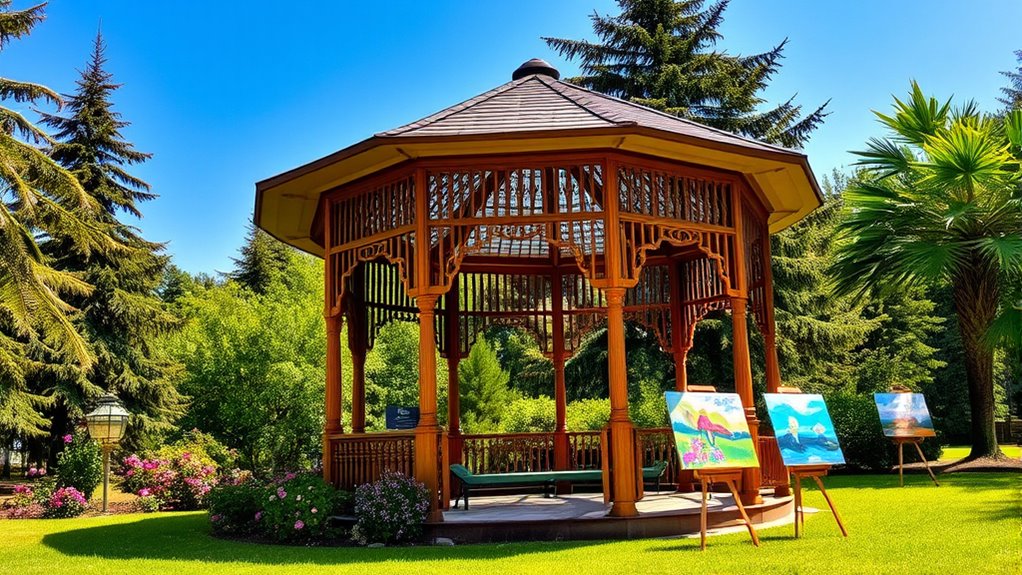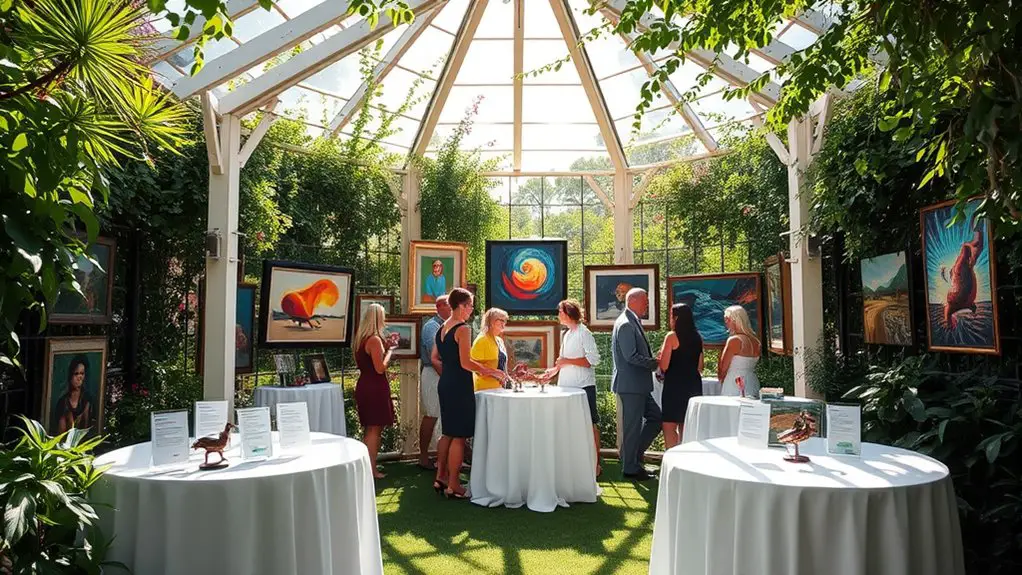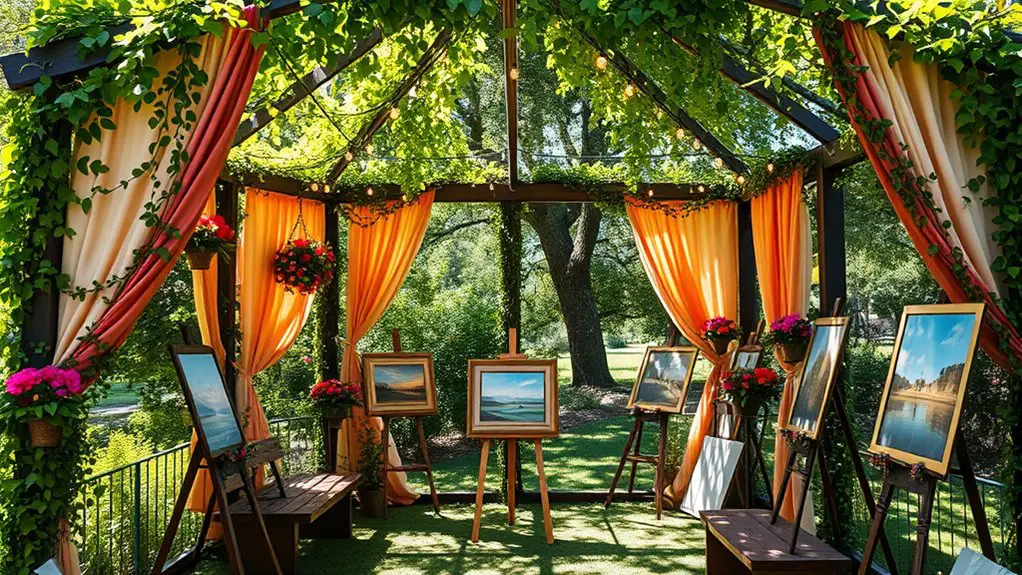To host an outdoor art exhibition in a gazebo, start by scouting locations that resonate with your theme, ensuring accessibility and good natural light. Plan the layout with smooth pathways and varied artwork heights. Select pieces that harmonize with the surroundings and enhance them with soft, diffused lighting. Create an inviting atmosphere with cohesive decor and comfortable seating. Don’t forget to prepare for weather changes and streamline the check-in process. Explore further for essential tips on community engagement and visitor amenities.
Selecting the Perfect Gazebo Location

When planning your outdoor art exhibition, selecting the perfect gazebo location can make all the difference in creating an inviting atmosphere. Begin with thorough location scouting—look for spaces that harmonize with your art’s essence. Is there a serene park, a vibrant community square, or a hidden garden that speaks to freedom and creativity?
Consider accessibility options, ensuring everyone can enjoy the experience. A location with smooth pathways and nearby parking can greatly enhance attendance, allowing art lovers from all walks of life to gather without barriers.
Think about natural light; a gazebo surrounded by trees can provide a soft, dappled glow, enhancing the artwork’s colors. Additionally, the surrounding environment should resonate with the themes of your exhibition, creating a cohesive experience. Remember, the right gazebo location not only showcases art but also invites connection and exploration, fostering a sense of community and shared inspiration. Furthermore, consider sun and shade exposure to ensure that both artists and visitors remain comfortable throughout the event.
Planning the Layout and Flow
To guarantee your outdoor art exhibition captivates and engages attendees, it’s essential to meticulously plan the layout and flow of the space. Think of the artistic flow as a journey that guides visitors through each piece, encouraging them to linger and reflect. Begin by envisioning the pathways—smooth, inviting routes that allow for easy navigation while fostering a sense of discovery.
Position artworks at varying heights and angles to create visual interest and a dynamic experience. Consider using signage to enhance the visitor experience, offering context and sparking conversations.
Leave open areas for relaxation and reflection, allowing attendees the freedom to absorb the surroundings. Remember, the goal is to create an environment where visitors feel inspired and connected to the art. With thoughtful planning, you’ll transform your gazebo into a vibrant space that celebrates creativity and community.
Choosing the Right Artwork

Choosing the right artwork is essential for setting the tone of your outdoor exhibition. You’ll want to evaluate how different art styles resonate with the natural surroundings, while also ensuring that the size and scale of each piece create a harmonious experience for your audience. Balancing these elements can transform your exhibition into a enchanting visual journey that invites engagement and reflection.
Art Style Considerations
The selection of artwork for an outdoor exhibition plays a crucial role in shaping the overall atmosphere and experience for attendees. You’ll want to reflect on styles like abstract expressionism and contemporary realism, as they can evoke different emotions and responses. For a harmonious exhibit, think about how these styles interact with your outdoor environment.
| Art Style | Emotional Impact | Ideal Setting |
|---|---|---|
| Abstract Expressionism | Evokes freedom, chaos | Open, dynamic spaces |
| Contemporary Realism | Relates to everyday life | Intimate, reflective spots |
| Impressionism | Captures fleeting moments | Serene, natural settings |
| Surrealism | Provokes thought | Unique, whimsical areas |
| Minimalism | Encourages contemplation | Clean, spacious areas |
Choosing the right artwork not only engages the audience but also enhances the freedom of expression that outdoor spaces offer.
Size and Scale
When curating an outdoor art exhibition, considering the size and scale of the artworks is just as important as the styles you select. The gazebo dimensions dictate the exhibition space, guiding your choices in a way that complements the natural surroundings. Opt for larger pieces that demand attention, creating a bold focal point, or choose smaller works that invite intimate exploration. Balance is key; oversized sculptures can overwhelm, while tiny pieces may get lost. Visualize the visitor’s journey through the exhibition—how each artwork interacts with its neighbors and the gazebo’s architecture. Embrace the freedom to experiment with scale, allowing the art to breathe in the open air and resonate with the audience, transforming the space into a vibrant cultural experience.
Lighting Considerations for Outdoor Exhibitions
Although outdoor exhibitions offer a unique canvas for creativity, the right lighting can transform the experience from mundane to mesmerizing. Consider using ambient lighting to create a warm, inviting atmosphere that encourages attendees to linger and explore. Soft, diffused light can enhance the natural beauty of your surroundings, allowing the artwork to breathe and resonate with the environment.
Incorporating spotlight techniques can further elevate the experience. By directing focused beams on key pieces, you can draw attention to their details and textures, creating focal points that captivate your audience. Experiment with adjustable spotlights to emphasize different works throughout the evening, adjusting as the natural light fades.
Ultimately, the interplay between ambient lighting and spotlight techniques can evoke emotion and inspire conversation. It’s about creating a harmonious balance that celebrates both the art and the outdoor space, inviting freedom of expression and exploration. Additionally, using energy-efficient LED lights can help reduce electricity bills while providing bright illumination for your exhibition.
Enhancing the Atmosphere With Decor

To create an enchanting ambiance for your outdoor art exhibition, consider how lighting and thematic decorations intertwine to elevate the experience. Thoughtful illumination can highlight key pieces while setting the mood, guiding visitors through a curated journey. Meanwhile, cohesive decorations not only reflect the art’s essence but also immerse your audience in a unique narrative that resonates long after they leave. Incorporating solar chandeliers can provide energy-efficient lighting that enhances both visibility and aesthetic appeal in your gazebo setting.
Lighting Considerations
As the sun sets and twilight envelops your outdoor art exhibition, the right lighting can transform the atmosphere, creating an enchanting experience for your guests. Consider incorporating ambient lighting to establish a warm, inviting glow that encourages exploration and conversation. String lights or soft lanterns can weave a magical tapestry overhead, setting the perfect backdrop for your artwork.
Additionally, pay attention to spotlight placement—directing light onto key pieces can draw your guests’ eyes, highlighting details and textures that might otherwise go unnoticed. Balancing these elements not only enhances the overall aesthetic but also fosters a sense of freedom and creativity, inviting your audience to linger and immerse themselves in the art.
Thematic Decorations
While your artwork takes center stage, thematic decorations can greatly enhance the overall atmosphere of your outdoor exhibition. By carefully selecting thematic color schemes that resonate with your art, you create a seamless visual narrative that invites exploration. Imagine soft pastels for serene pieces or bold hues for energetic works; the colors echo your artistic intent. Incorporating artistic centerpieces—perhaps sculptures or floral arrangements—can draw attention and spark conversation, providing focal points that enrich the experience. Consider the interplay of natural elements, like using greenery to frame your pieces, creating a harmonious blend between art and nature. Ultimately, these thoughtful decorations transform your gazebo into an immersive environment where creativity flourishes and visitors feel free to engage with the art on a deeper level.
Engaging the Community and Promoting the Event
Engaging the community and promoting your outdoor art exhibition can transform it from a simple showcase into a vibrant cultural event. Start by leveraging community outreach; connect with local artists, schools, and organizations to foster a sense of ownership among attendees. Utilize social media platforms to create buzz and share behind-the-scenes content, inviting the community to participate in the journey. Consider hosting pre-event workshops or discussions to ignite interest and spark creativity.
For effective event promotion, craft eye-catching posters and flyers that highlight featured artists and unique installations. Encourage word-of-mouth by engaging local influencers and art enthusiasts who can amplify your message. By anchoring your exhibition to the community’s spirit, you’ll not only draw people in but also cultivate lasting connections and appreciation for the arts. This collaborative approach will elevate your event, making it a celebration of creativity and togetherness that everyone can embrace. Additionally, hosting the exhibition in a gazebo can provide shade and shelter from the elements, ensuring a comfortable experience for all attendees.
Providing Amenities for Visitors
Creating a welcoming atmosphere at your outdoor art exhibition is vital for enhancing visitor experience. You’ll want to provide various visitor amenities to guarantee everyone feels comfortable and engaged. Comfort stations are important, offering restrooms and refreshment options; they help visitors unwind and linger longer.
Here’s a simple breakdown of key amenities:
| Amenity | Purpose |
|---|---|
| Comfort Stations | Provide essential restroom access |
| Seating Areas | Encourage relaxation and discussion |
| Refreshment Stands | Fuel creativity and enjoyment |
Ensuring Weather Preparedness
When planning your outdoor art exhibition, monitoring the weather forecast is essential for a seamless experience. Consider protective cover options not just for artworks, but for your guests too, ensuring everyone stays comfortable regardless of the elements. Finally, implementing a solid emergency plan will provide peace of mind, making your event a resounding success even if unexpected weather strikes. Additionally, selecting a gazebo with weather resistance features can enhance protection against rain and snow, ensuring your exhibition remains enjoyable for all.
Weather Forecast Monitoring
Although outdoor art exhibitions offer a unique opportunity to connect with nature and the community, they also come with the unpredictability of the weather. To navigate this challenge, you should embrace modern technology. Utilize weather apps that provide real-time updates and forecasts, allowing you to anticipate changes in climate patterns. By monitoring these forecasts regularly, you can make informed decisions about your exhibition’s timing and setup. Visualize your event not as a rigid schedule but as a dynamic experience, responsive to nature’s whims. This adaptability guarantees that your artistic vision flourishes, no matter the conditions. Ultimately, staying attuned to the weather will empower you to create a free-spirited atmosphere, where art and nature harmoniously coexist.
Protective Cover Options
Even with careful weather monitoring, unexpected changes can occur, making protective cover options essential for your outdoor art exhibition. You’ll want to guarantee your art is safe and attendees remain comfortable, so consider various shelter options.
- Canopies: Lightweight and easy to set up, these provide instant shade and rain protection.
- Tarps: Versatile material types that can be draped over displays or structures for quick coverage.
- Pop-up tents: Portable and sturdy, these offer excellent shelter and can accommodate larger groups.
- Awnings: Permanent fixtures that can enhance aesthetics while providing ongoing protection from the elements.
Emergency Plan Implementation
While it might be tempting to focus solely on the artistic elements of your outdoor exhibition, having a robust emergency plan is essential for ensuring weather preparedness. Start by identifying emergency contacts—local authorities, medical services, and weather stations—so you can act swiftly when needed. Clearly define evacuation routes for guests, making sure they’re visible and accessible. Consider using signage that directs attendees to safe areas during adverse weather. Regularly communicate updates to your audience through social media or announcements, keeping everyone informed and calm. By prioritizing these aspects, you empower your guests with a sense of security, allowing them to fully immerse themselves in the art without anxiety about the elements. A thoughtful plan transforms a potential crisis into a seamless experience.
Setting Up an Efficient Check-In Process
An efficient check-in process can make or break the experience of your outdoor art exhibition, setting the tone for both attendees and artists alike. To create a seamless experience, consider implementing reliable check-in software that simplifies the process. This allows for quick access to guest lists, reducing wait times and ensuring everyone feels welcomed.
An efficient check-in process is vital for your outdoor art exhibition, ensuring a warm welcome and a positive experience for all.
Here are some key elements to focus on:
- Clear Signage: Use visible signs directing guests to the check-in area.
- Volunteers: Train volunteers effectively for smooth coordination and friendly assistance.
- Mobile Check-In: Enable mobile check-in options for those who prefer a tech-savvy approach.
- Welcome Kits: Prepare small welcome kits with event details and artist information to enhance the experience.
Gathering Feedback and Follow-Up Opportunities
To guarantee your outdoor art exhibition leaves a lasting impact, gathering feedback from attendees and artists is essential. This feedback collection process should be seamless and engaging. Consider using digital surveys or feedback cards, allowing participants to share their thoughts freely. Ask open-ended questions that invite honest reflections, such as what resonated with them and what could be improved.
Once you’ve collected this valuable feedback, implement follow-up strategies to maintain connections. Send thank-you emails that include highlights from the exhibition and insights gained from their responses. You might also invite them to future events, creating a sense of community and ongoing dialogue.
Frequently Asked Questions
What Permits Are Required for Hosting an Outdoor Art Exhibition?
When planning an outdoor art exhibition, you’ll need to check event regulations and local guidelines. Understanding these requirements helps you create a seamless experience, fostering creativity while respecting community standards and ensuring your event’s success.
How Can I Ensure Artwork Is Protected From the Elements?
Did you know that 40% of outdoor art suffers damage from weather? To guarantee art protection, consider weather considerations like waterproof coverings, elevated platforms, and strategic placement to shield pieces from rain, sun, and wind.
What Types of Seating Should I Provide for Visitors?
To enhance visitor experience, consider providing folding chairs for comfort and picnic blankets for a relaxed vibe. This mix invites freedom of movement, allowing guests to engage with art while enjoying the outdoor atmosphere.
How Do I Attract Local Artists to Participate in the Exhibition?
To attract local artists, focus on artist outreach and community engagement. Create a vibrant platform showcasing their work, foster connections, and emphasize collaboration. Your vision can ignite creativity, inviting artists to freely express their talents.
What Should I Do if the Weather Forecast Predicts Rain?
When rain threatens, envision your vibrant art contrasting with dreary skies. Prepare a rain contingency; consider shelter options like tents or indoor spaces. Your artists and visitors will appreciate your foresight, ensuring creativity flourishes despite weather.

